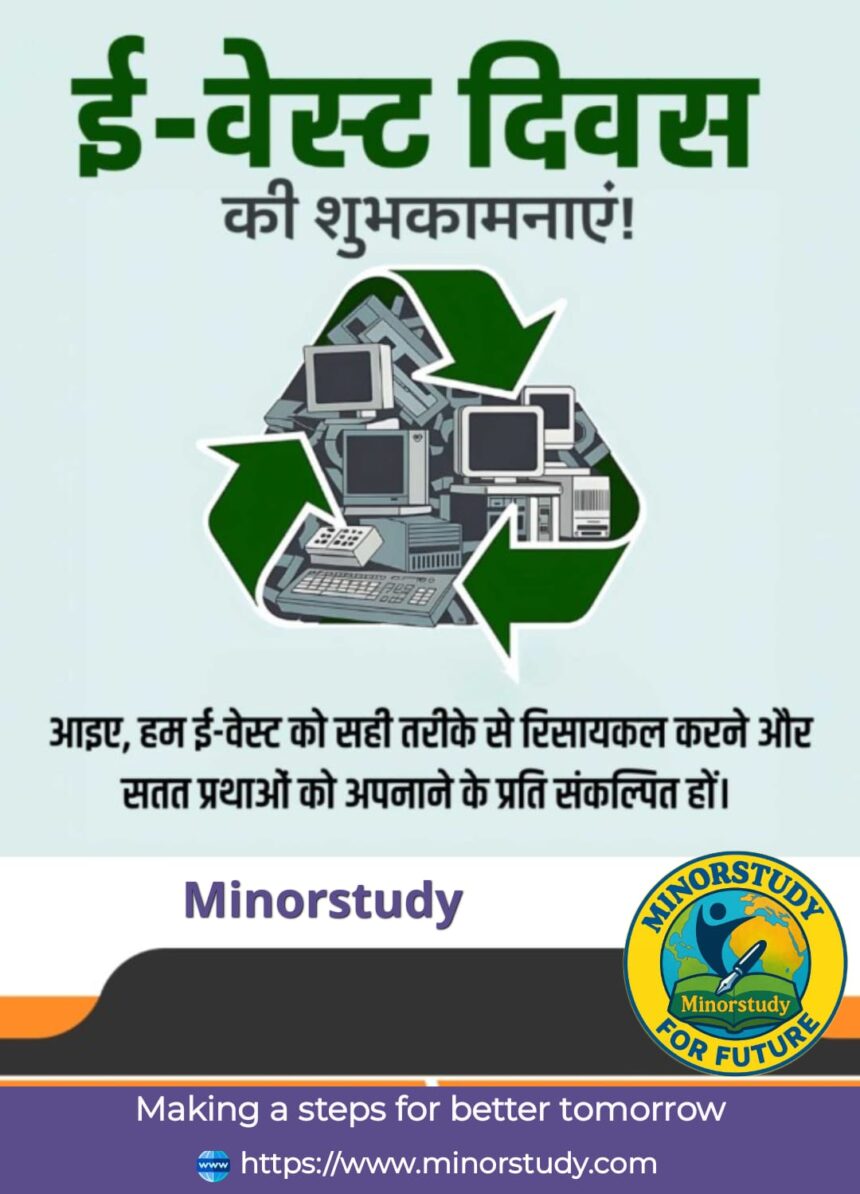🌍 E-Waste Day: History, Facts, Meaning & Everyday Impact
In an age of smartphones, smart homes, and rapid tech turnover, electronic waste—commonly called e-waste—is one of the world’s fastest growing waste streams. International E-Waste Day is observed annually to raise awareness, spark action, and remind us that our discarded devices still have value and risks.
- 1. What Is E-Waste & Why It Matters
- 2. History & Timeline of International E-Waste Day
- 3. Facts & Figures You Must Know
- 4. Significance & Purpose
- Awareness & Behavior Change
- Policy & Regulation
- Circular Economy & Resource Efficiency
- Community & Participation
- 5. Observance, Practices & How to Participate
- Collection & Recycling Events
- Awareness & Education
- Repair & Refurbish Drives
- Corporate & Institutional Actions
- Policy & Advocacy
- 6. Wishing & Messaging for E-Waste Day
- 7. Frequently Asked Questions (FAQs)
- 8. Daily Life & Societal Impact
- For Individuals & Households
- In Communities
- In Business & Industry
- For Governments & Policy
- Environmental & Health Benefits
- 9. Important Points (Key Takeaways)
- 10. Conclusion: Why E-Waste Day Matters—Now & Always
In this long-form guide, we’ll explore the history, timeline, significance, facts, FAQs, observance practices, wishing/messages, and the real impact of E-Waste Day on society and personal life. I’ll aim to keep it human-friendly, relatable, and behavior-oriented.
Let’s begin by knowing why E-Waste Day matters today more than ever.
1. What Is E-Waste & Why It Matters
E-waste (electronic waste) includes discarded electrical or electronic devices (or components thereof) that have reached end of life: broken smartphones, old laptops, chargers, cables, refrigerators, CRT monitors, printers, battery-powered toys, and so on.
Why is it a concern?
Many devices contain hazardous materials — lead, mercury, cadmium, flame retardants, and other toxic chemicals. If improperly disposed, they leach into soil and groundwater.
On the flip side, they also contain valuable materials — gold, silver, copper, rare earth metals, and critical raw materials (CRMs) that are increasingly scarce.
The volume of e-waste is growing faster than our capacity to recycle or manage it responsibly. Geneva Environment Network+3WEEE Forum+3Geneva Environment Network+3
Improper handling (burning, dumping in landfills, informal recycling) leads to health risks, environmental pollution, and contributes to climate change.
So e-waste is a double-edged problem: it’s a waste challenge and a resource opportunity.
2. History & Timeline of International E-Waste Day
Origins & Launch
International E-Waste Day was introduced in 2018 by the WEEE Forum (Waste from Electrical and Electronic Equipment) to raise awareness around responsible e-waste management. Recycling Today+3Days Of The Year+3Basel Convention+3
The idea was that a dedicated “day” would galvanize consumers, companies, NGOs, and governments to take action—especially around recycling, reuse, and collection. Days Of The Year
The Basel Convention also lends institutional backing: the Basel Convention deals with controlling transboundary movement of hazardous wastes (including e-waste). Basel Convention+1
Key Milestones
| Year | Event / Milestone | Significance |
|---|---|---|
| 2018 | First International E-Waste Day (October 13) | Launch of the awareness movement globally. Recycling Today+2The Recycler+2 |
| 2019 | 2nd E-Waste Day, >100 organizations join | Broader reach: 112 organizations from ~48 countries participated. RECYCLING magazine |
| 2022 | Basel Convention integrates stricter e-waste controls | From 2025 onward, e-waste across borders will face stricter Procedures (Prior Informed Consent) under Basel amendments. BRS MEAs+2BRS MEAs+2 |
| 2023 | Theme: “You can recycle anything with a plug, battery or cable!” | Focus on “invisible” e-waste (small gadgets hidden in drawers) Geneva Environment Network |
| 2024 / 2025 | Emphasis on Critical Raw Materials (CRMs) | Highlighting how e-waste can supply rare materials for clean tech & digital transition. WEEE Forum+1 |
Thus the observance has grown from a modest awareness day to a global event involving NGOs, governments, consumers, and the electronics industry.
3. Facts & Figures You Must Know
Huge Global Volume
In 2022 alone, the world generated 62 billion kg (62 million metric tons) of e-waste. WEEE Forum+3WEEE Forum+3Geneva Environment Network+3
Projections estimate 82 million tons by 2030. WEEE Forum+2Geneva Environment Network+2Recycling Rate is Low
Less than 20% of global e-waste is collected and properly recycled. Days Of The Year+2Geneva Environment Network+2
This means 80% or more ends up in landfills, incinerated, or handled by informal sectors without safety.Rapid Growth Trend
Since 2010, the generation of e-waste has been growing 5 times faster than the formal recycling sector. WEEE Forum+1Invisible E-Waste Problem
Many small electronics—chargers, USB sticks, smart devices—are hidden in drawers and never recycled. These “tiny items” add up. Geneva Environment Network+1Critical Raw Materials (CRMs)
Modern e-waste contains CRMs: rare earths, cobalt, lithium, etc. Recovering them from discarded devices is essential for sustainable tech and green transitions. WEEE Forum+1Health & Environmental Risk
Informal recycling—burning circuits, acid leaching—exposes workers to toxic fumes (lead, mercury), contaminates soil and water, and impacts public health in local communities.Strong Institutional Support
The Basel Convention has adopted guidelines on e-waste movement and waste vs. non-waste classification. From 2025, cross-border e-waste movement will face stricter controls. Basel Convention+2BRS MEAs+2Widespread Participation
In 2024 alone, 160 organizations across 47 countries officially joined E-Waste Day efforts. WEEE ForumCO₂ & Resource Savings
Recycling materials avoids virgin mining, saves energy, reduces greenhouse gas emissions, and reduces the burden on ecosystems.
These facts make it clear: E-Waste Day is not just symbolic — it speaks to urgent environmental, health, and resource challenges—and opportunities.
4. Significance & Purpose
Why do we need International E-Waste Day? What deeper roles does it play?
Awareness & Behavior Change
Many people don’t realize how harmful or valuable their “junk drawer” electronics are. The day helps:
Educate consumers about e-waste hazards
Encourage people to retrieve, recycle, and revive old electronics
Break myths: “It’s too small to recycle,” “It’s okay to throw away”
Policy & Regulation
E-Waste Day gives a platform to:
Advocate for stronger e-waste laws and enforcement
Push for Extended Producer Responsibility (EPR) (electronics manufacturers take responsibility for disposal)
Promote safe and regulated recycling infrastructure
Circular Economy & Resource Efficiency
Emphasize how recycled electronics feed the loop of production rather than being dumped
Enhance local supply of CRMs, reducing dependence on raw mining
Incentivize repair, refurbishment, and reuse
Community & Participation
Mobilize schools, NGOs, businesses, and municipalities to host collection drives
Encourage active citizenship: individuals can make a difference
Build culture: making recycling and responsible disposal a social norm
In short, E-Waste Day is both wake-up call and action engine.
5. Observance, Practices & How to Participate
If you want to meaningfully observe E-Waste Day (or turn it into a campaign), here are proven practices and ideas:
Collection & Recycling Events
Host community drop-off points for e-waste (phones, laptops, cables)
Partner with certified recyclers to ensure proper handling
Offer pick-up services for people who cannot transport devices themselves
Awareness & Education
Workshops in schools to teach kids about e-waste, reuse, and repair
Social media campaigns about small electronics and “invisible” e-waste
Infographics and videos explaining recycling, CRMs, and health impacts
Repair & Refurbish Drives
Encourage repair cafes: people bring broken devices, helpers repair them
Donate usable but old devices to charities or low-income communities
Promote modular, repairable designs
Corporate & Institutional Actions
Electronics companies commit to take-back schemes
Offices run internal e-waste collection campaigns
Public institutions (universities, libraries) clear old inventory responsibly
Policy & Advocacy
Lobby local government to provide e-waste bins, infrastructure, and laws
Demand transparency from electronics makers (how they recycle)
Support international treaties (like Basel) and local regulation
By combining awareness, collection, repair, and policy, observance becomes real change.
6. Wishing & Messaging for E-Waste Day
When sending out E-Waste Day messages (on social media, newsletters, community), here are thoughtful templates:
♻️ On this E-Waste Day, let’s commit to retrieving, recycling, and reviving our electronics — every device counts!
May your “junk drawer” become a treasure trove of reusable parts. Happy E-Waste Day!
Let’s turn discarded gadgets into renewed opportunities — for health, planet, and future generations.
Let’s not waste our waste — on this E-Waste Day, act responsibly and inspire others.
Sending you green wishes: may your e-waste find its path to circularity today and beyond.
These messages are small nudges but can build community momentum.
7. Frequently Asked Questions (FAQs)
Q1. When is International E-Waste Day?
International E-Waste Day is observed on 14 October each year. Geneva Environment Network+3Basel Convention+3Geneva Environment Network+3
Q2. Why 14 October?
The WEEE Forum designated this date starting from 2018 to standardize the yearly observance. Days Of The Year+3Basel Convention+3Recycling Today+3
Q3. Who started E-Waste Day?
It was initiated by the WEEE Forum with support from many e-waste collection and recycling schemes globally. Geneva Environment Network+3Days Of The Year+3Basel Convention+3
Q4. What does “e-waste” include?
Anything with a plug, battery, or electrical component: phones, chargers, cables, laptops, household appliances, LED lights, etc. Days Of The Year+3Geneva Environment Network+3Geneva Environment Network+3
Q5. Why is only ~20% recycled?
Challenges: lack of awareness, insufficient collection systems, informal recycling, hiding devices at home, costs of transport and processing. WEEE Forum+3Days Of The Year+3Geneva Environment Network+3
Q6. What are CRMs and why are they important in e-waste?
CRMs are Critical Raw Materials like rare earth elements, lithium, cobalt, etc. They are essential for modern tech (batteries, magnets). Recovering them from e-waste reduces mining and ensures supply security. WEEE Forum+1
Q7. Is disposing small gadgets (like earphones) worth recycling?
Yes — small electronics often contain gold, copper, precious metals. The “invisible” e-waste problem is real. Geneva Environment Network+1
Q8. How does Basel Convention relate to e-waste?
The Basel Convention regulates cross-border movement of hazardous waste. As of 2025, all e-waste exports/imports will need stricter consent and controls under amendments. BRS MEAs+2BRS MEAs+2
Q9. What can a regular person do?
Retrieve unused electronics, donate or recycle, prefer repair over replacement, support legislation, and spread awareness.
8. Daily Life & Societal Impact
How does the observance and spirit of E-Waste Day ripple into everyday life and society?
For Individuals & Households
You begin to clean out your drawers and boxes of forgotten electronics
You may rethink your consumption habits: buy fewer, repair more
You shift mindset—electronics are not disposable but part of a lifecycle
You may discover that your “junk” has resale or recycling value
In Communities
Local drives and drop-off stations build social cohesion
Schools and youth engage in environmental stewardship
Neighborhoods adopt better waste segregation and electronic collection
In Business & Industry
Manufacturers adopt take-back programs, modular designs, circular business models
Informal recycling sectors may be formalized, bringing safer jobs
New recycling infrastructure and startups emerge
For Governments & Policy
Stronger enforcement of e-waste laws
Incentives for green electronics, repair, recycling
Integration with climate and circular economy goals
Environmental & Health Benefits
Reduced soil, water, and air pollution
Less hazardous exposure to communities near dumping sites
Conservation of resources and biodiversity
Lower carbon footprint by avoiding virgin material extraction
Hence E-Waste Day is not just symbolic — it nudges everyday behavior, corporate models, and systemic change.
9. Important Points (Key Takeaways)
E-waste is a fast-growing waste stream with both risks and value.
Less than 20% is properly recycled globally.
International E-Waste Day (14 October) was launched in 2018 by WEEE Forum.
Basel Convention amendments strengthen regulation of e-waste across borders from 2025.
CRMs in electronics make recycling strategically important.
Invisible gadgets (small devices) are a huge part of the e-waste equation.
Repair, reuse, take-back, and circular design are critical.
Each person’s action (retrieving and recycling) matters in aggregate.
10. Conclusion: Why E-Waste Day Matters—Now & Always
E-Waste Day is more than a calendar date—it’s a call to consciousness and action. In a world where technology evolves rapidly, we often neglect the tail-end of that evolution—our discarded, broken, or unused devices.
But these gadgets carry hidden costs (pollution, health hazards, resource depletion) and hidden value (metals, materials, circular potential). E-Waste Day encourages us to pause and reflect: What do we throw away? Why do we replace so fast? How do our habits affect soil, water, communities, and future generations?
On this day and beyond, each small act—retrieving your old charger, handing over a dead smartphone, supporting a take-back drive—adds up. Collectively, these micro-actions can steer us toward a more sustainable, equitable, and circular future.
So, on E-Waste Day, may we all commit to retrieving, recycling, and reviving—not just for a day, but as a habit. Because when we waste our waste responsibly, we protect nature, empower communities, and conserve resources for tomorrow.









**breathe**
breathe is a plant-powered tincture crafted to promote lung performance and enhance your breathing quality.